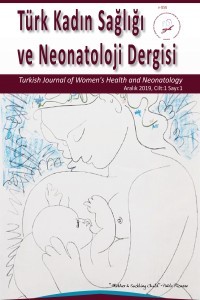Anesteziyoloji Perspektifinden Yeniden Gözden Geçirilen Plasenta Previa ve Plasenta Accrete İle İlişkili Perioperatif Sonuçlar, Riskler ve Komplikasyonlar
Amaç: Plasenta previa (PP) ve plasenta akreta spektrumu, anormal plasentasyon biçimleridir ve önemli perinatal morbidite ve mortalite ile ilişkilidir. Bu çalışmanın amacı, PP ve plasenta akreta spektrumu ile ilişkili temel verileri, klinik özellikleri, perioperatif sonuçları, riskleri ve komplikasyonları yan yana getirmekti.
Gereç ve Yöntemler: Bu retrospektif çalışma, PP (Grup I, n=237) ve plasenta akreta spektrumu (Grup II, n=63) tanısı alan toplam 300 hastanın tıbbi dosyalarından elde edilen veriler kullanılarak yapıldı. Her hasta için toplanan bilgiler perinatal veriler ve intraoperatif veya postoperatif kan transfüzyonu ihtiyacı, hemoglobin, fibrinojen ve C-reaktif proteinin pre- ve postoperatif serum seviyeleri, yoğun bakımda kalış süresi ve ihtiyacı, hemodiyaliz ve mekanik ventilasyon kullanılıp kullanılmadığından oluşuyordu..
Bulgular: Vücut kitle indeksi Grup II’de oldukça yüksekti (p=0,002). Temel tanımlayıcı veriler ve perinatal, perioperatif ve postoperatif değişkenler açısından iki grup arasında istatistiksel olarak anlamlı bir fark yoktu.
Sonuç: Bu çalışmanın sonuçları, yeterli planlama ve optimal yönetim stratejilerine rağmen; PP ve plasenta accreta spektrumu ile ilişkili önemli morbidite ve mortalite olasılığının hala dikkat çekici olduğu göstermiştir.. Dikkatli bir hazırlık ile erken ve yakın takip, antepartum ve intrapartum yönetim için çok önemlidir. Predispozan faktörlerin yanı sıra ideal tanı, tedavi ve önleme yöntemlerini belirlemek için ek araştırmalar gereklidir.
Anahtar Kelimeler:
Plasenta previa, plasenta accreta, plasenta percreta, plasenta increta, obstetrik risk faktorler, komplikasyonlar
Perioperative Outcomes, Risks and Complications Associated with Placenta Previa and Placenta Accreta Spectrum Revisited From an Anesthesiology Perspective
Purpose: Placenta previa (PP) and placenta accreta spectrum are forms of abnormal placentation, and they are associated with significant perinatal morbidity and mortality. The objective of the present study was to juxtapose the baseline data, clinical features, perioperative outcomes, risks, and complications associated with PP and placenta accreta spectrum.
Materials and Methods: This retrospective study was performed using data extracted from the medical files of a total of 300 patients diagnosed with PP (Group I, n=237) and placenta accreta spectrum (Group II, n=63). The information gathered for every patient consisted of baseline descriptives, perinatal data and need for intraoperative or postoperative blood transfusion, pre- and postoperative serum levels of hemoglobin, fibrinogen and C-reactive protein, need and duration for intensive care unit stay, whether hemodialysis and mechanical ventilation were employed.
Results: The body-mass index was remarkably higher in Group II (p=0.002). There was no statistically significant difference between two groups concerning baseline descriptive data and perinatal, perioperative, and postoperative variables.
Conclusion: Results of the present study demonstrated that despite adequate planning and optimal management strategies; the likelihood of significant morbidity and mortality associated with PP and placenta accrete spectrum is still remarkable. Early and close monitoring with careful preparation is momentous for antepartum and intrapartum management. Additional research is essential to determine the predisposing factors as well as ideal methods of diagnosis, treatment, and prevention.
Keywords:
Placenta previa, placenta accreta, placenta percreta, placenta increta, obstetric risk factors, complication,
___
- Silver RM, Barbour KD. Placenta accreta spectrum: accreta, increta, and percreta. Obstet Gynecol Clin North Am 2015;42:381-402.
- D’Antonio F, Bhide A. Ultrasound in placental disorders. Best Pract Res Clin Obstet Gynaecol 2014;28:429-442.
- Faiz AS, Ananth CV. Etiology and risk factors for placenta previa: An overview and meta-analysis of observational studies. J Matern Fetal Neonatal Med 2003;13:175-90.
- Iyasu S, Saftlas AK, Rowley DL, Koonin LM, Lawson HW, Atrash HK. The epidemiology of placenta previa in the United States, 1979 through 1987. Am J Obstet Gynecol 1993;168:1424-1429.
- Rao KP, Belogolovkin V, Yankowitz J, Spinnato JA. Abnormal placentation: evidence-based diagnosis and management of placenta previa, placenta accrete, and vasa previa. Obstet Gynecol Surv 2012;67:503-519.
- Rowe T. Placenta previa. J Obstet Gynaecol Can 2014;36:667-668.
- Jauniaux E, Collins S, Burton GJ. Placenta accreta spectrum: pathophysiology and evidence-based anatomy for prenatal ultrasound imaging. Am J Obstet Gynecol 2018;218:75-77.
- Kassem GA, Alzahrani AK. Maternal and neonatal outcomes of placenta previa and placenta accreta: Three years of experience with a two-consultant approach. Int J Womens Health 2013;28:803-810.
- Solheim K, Esakoff T, Little SE, Cheng YW, Sparks TN, Caughey AB. The effect of cesarean delivery rates on the future incidence of placenta previa, placenta accreta, and maternal mortality. J Matern Fetal Neonatal Med 2011;24:1341-1346.
- Tuzovic L, Djelmis J, Ilijic M. Obstetric risk factors associated with placenta previa development: Case-control study. CMJ 2003;44:728-733.
- Kollmann M, Gaulhofer J, Lang U, Klaritsch P. Placenta praevia: incidence, risk factors and outcome. J Matern Fetal Neonatal Med 2016;29:1395-1398.
- Başlangıç: 2019
- Yayıncı: Sağlık Bilimleri Üniversitesi Etlik Zübeyde Hanım Kadın Hastalıkları Eğitim ve Araştırma Hastanesi
Sayıdaki Diğer Makaleler
Pandemi Döneminde Doğum Sonrası Depresyon ve İlişkili Faktörler; Kesitsel Bir Araştırma
